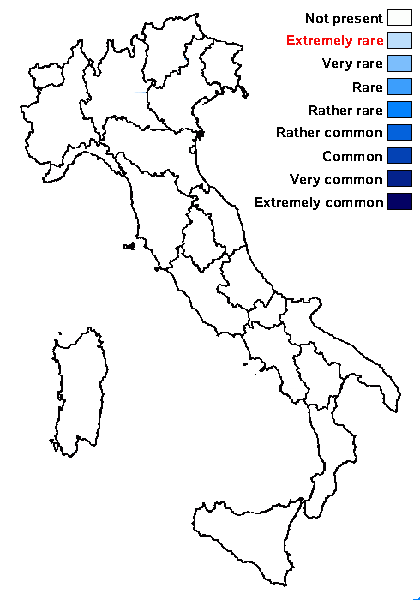Circinaria navarroi (Cl. Roux & M. Bertrand)
(provisionally placed here, ICN Art. 36.1b). . Basionym: Aspicilia navarroi Cl. Roux & M. Bertrand - in Roux & coll., Cat. lichens et champignons lichénicoles de France métropolitaine, 3rd ed.: 1273, 2020.
Synonyms:
Distribution:
Description: Thallus crustose, episubstratic, whitish, sometimes with a bluish or pale ochraceous hue, usually pruinose-farinose, not turning green when wet, 0.1-0.6 mm thick, areolate to areolate-subsquamulose, rarely rimose-areolate, poorly delimited and usually consisting of dispersed, polygonal or rarely rounded 0.35-1.6 mm wide, flat to slightly convex areoles, without a visible prothallus. Epinecral layer 10-35 μm thick, filled with small crystals of calcium oxalates; cortex 25-75 μm thick, paraplectenchymatous, the upper part brownish green, the pigment N+ emerald green, K+ yellow-brown (Caesiocinerea-green pigment); algal layer 45-170 thick, interrupted by columns of hyphae; medulla white, 50-300 μm thick, rich in clusters of crystals of calcium oxalates, I-. Apothecia cryptolecanorine-aspicilioid, at first immersed, then rapidly subsessile and finally often constricted at base, 1(-3) per areole, at maturity occupying almost the entire surface of the areole, mostly round, sometimes slightly elongate and 0,3-1.7 x 0,3-1.2 mm, with a concave to flat, finely rugose, epruinose or usually grey-pruinose disc, and a markedly raised, 0.1-0.65 mm thick thalline margin. Proper exciple poorly developed, colourless; epithecium brownish green, 13-25(-35) μm high, N+ emerald green, K+ yellowish brown, the upper part with numerous small crystals of calcium oxalates; hymenium colourless, 110-215 μm high, I+ blue turning reddish brown; paraphysoids coherent, sparingly branched, anastomosing, 1.5-2 μm thick at base, the terminal cell clearly swollen; subhymenium and hypothecium colourless, 65-100 μm high. Asci (3-)4(-5)- spored, clavate to subcylindrical, the thin outer coat K/I+ blue, the wall and apical dome K/I-, with uniseriately arranged spores. Ascospores 1-celled, hyaline, broadly ellipsoid to subglobose, (15.5-)18.5-28(-32) x (14.5-)15.5-22(-24.5) μm. Pycnidia rare, immersed in the areoles, the periostiolar area brownish green, the wall colourless. Conidia bacilliform, straight or slightly curved, (4.5-)5.5-8(-9.5) x 1-1.5 μm. Photobiont chlorococcoid. Spot tests: cortex and medulla K-, C-, KC-, P-. Chemistry: cortex and medulla without lichen substances; apothecia with the Caesiocinerea-green pigment. Note: a recently-described species of calcareous rocks, most frequent in upland areas, known from the southern Alps of France, with some stations not far from the Italian border. To be looked for in Italy.
Growth form: Crustose
Substrata: rocks
Photobiont: green algae other than Trentepohlia
Reproductive strategy: mainly sexual

Predictive model
Growth form: Crustose
Substrata: rocks
Photobiont: green algae other than Trentepohlia
Reproductive strategy: mainly sexual

Predictive model


